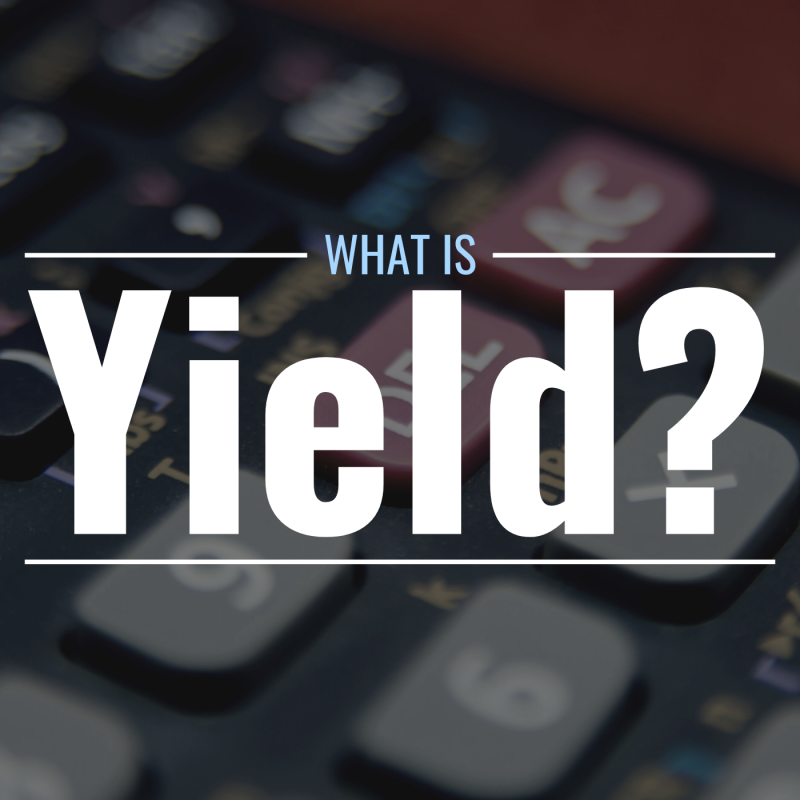
When it comes to investing, there are two ways to make money—capital gains and income. Capital gains occur when an investment’s principal value increases over time. Income, on the other hand, comes in the form of dividends, coupon payments, or other cash disbursements associated with the ownership of an asset.
What does yield mean in finance?
Yield refers to the income received from an asset or investment over a certain period of time—often annually—as a proportion of the investment itself. It is expressed as a percentage of the purchase price, face value, or market value of the associated asset.
For instance, if a stock with a market value of $50 paid $1.75 in dividends over the course of a year, its annual yield would be 3.5% because $1.75 is 3.5% of $50.
It’s important to note that yield excludes capital gains (changes in the value of the investment or asset itself)—it is only concerned with income received due to the ownership of an asset. That asset could be a stock, a bond, or even a piece of real estate.
How is yield calculated?
Yield is calculated by dividing the income derived from the ownership of an asset over a certain time period—often a year—by the value or purchase price of that asset. Let’s take a look at how to calculate the yield of a few different types of assets.
Dividend yield of a stock
Dividend Yield of a Stock = Total Annual Dividends / Stock Price
Dividend yield example
Let’s say a stock trades at $67 and pays a quarterly dividend of $0.45. What is its annual dividend yield?
Dividend Yield = Total Annual Dividends / Stock Price
Dividend Yield = ($0.45 + $0.45 + $0.45 + $0.45) / $67
Dividend Yield = $1.80 / $67
Dividend Yield = 0.02686 = 2.68%
Bond yield
Bond Yield = Annual Coupon Payment / Bond Price
Bond yield example
Let’s say a bond trades at $300 and pays a $6 coupon twice a year. What is the bond’s current annual yield?
Bond Yield = Annual Coupon Payument / Bond Price Price
Bond Yield = ($6 + $6) / $300
Bond Yield = $12 / $300
Bond Yield = 0.04 = 4%
Rental property yield
Rental Property Yield = Annual Rent Payments / Rental Property Value
Rental property yield example
Let’s say an investor owns a house worth $150,000, and tenants pay them $750 in rent each month. What is the annual yield of the rental property?
Rental Property Yield = Annual Rent Payments / Property Value
Rental Property Yield = ($750 * 12) / $150,000
Rental Property Yield = $9,000 / $150,000
Rental Property Yield = 0.06 = 6%
What’s the difference between yield and total return?
While yield takes only income into account, total return includes gains (increases in an asset’s value) as well.
For instance, let’s say a stock was purchased for $45. Over the course of a year, let’s say it paid $3 in dividends and went up in value to $55. At the end of the year, the stock’s dividend yield would be 5.5% ($3 / $55). Its total return, which includes capital gains ($10) and dividends ($3), would be 23.6% ($13 / $55).
What types of assets offer high yields?
Many different assets provide income and therefore offer a yield. Assets that consistently provide income payments at a fixed rate on a regular basis are referred to as fixed-income investments. Below are some examples of assets known to provide their owners with a regular cash flow.
- Rental properties: Investors who own real estate can rent their property out and receive regular rent payments from their tenants.
- REITs: Real estate investment trusts, or REITs, are companies that invest in real estate and/or real estate loans and distribute 90% or more of their annual profits to shareholders as dividends.
- Bonds: Bonds are loans from investors to corporations or governments, and they pay a fixed coupon rate expressed as a percentage of their face value. So-called “junk” bonds often offer the highest yields, but they also tend to have the highest risk of default.
- Preferred stock: Some companies offer preferred shares in addition to common stock. These shares typically pay a regular, fixed dividend that takes priority over (is paid out before) any divdends associated with common shares.
- Annuities: Annuities are contracts between investors and insurance companies that are typically used to disburse retirement income.
- Money market funds: Money-market funds are low-risk, fixed-income-focused mutual funds that are often used by consumers as savings vehicles.







